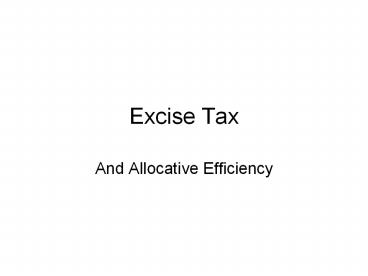Excise%20Tax - PowerPoint PPT Presentation
Title:
Excise%20Tax
Description:
Excise Tax And Allocative Efficiency Effect of a $.15 Excise Tax Effect of a $.15 Excise Tax Suppose the elasticity of demand for the good is similar to the ... – PowerPoint PPT presentation
Number of Views:57
Avg rating:3.0/5.0
Title: Excise%20Tax
1
Excise Tax
- And Allocative Efficiency
2
Effect of a .15 Excise Tax
.50
.45
Quantity Supply Price Before Tax Supply Price After Tax
50 .10
100 .15
150 .20
200 .25
250 .30
300 .35
.40
.35
S
.30
.25
.20
.15
.10
.05
100
150
200
250
300
50
3
Effect of a .15 Excise Tax
.50
S1
.45
Quantity Supply Price Before Tax Supply Price After Tax
50 .10 .25
100 .15 .30
150 .20 .35
200 .25 .40
250 .30 .45
300 .35 .50
.40
.35
S
.30
.25
.20
.15
.10
.05
100
150
200
250
300
50
4
Suppose the elasticity of demand for the good is
similar to the elasticity of supply
.50
.45
What is the equilibrium price? What is the
equilibrium quantity? What is the consumer
surplus at equilibrium? What is the producer
surplus at equilibrium? Assuming this is a
competitive market, In what way is this
efficient?
.40
.35
S
.30
.25
.20
.15
D
.10
.05
100
150
200
250
300
50
5
Now lets put that tax in place
.50
.45
What is the new equilibrium price? What is the
new equilibrium quantity? What is the consumer
surplus at the new equilibrium? What is the
producer surplus at the new equilibrium? Assuming
this is a competitive market, In what way is this
efficient?
S1
.40
.35
S
.30
.25
.20
.15
D
.10
.05
100
150
200
250
300
50
6
Deadweight loss to society
.50
.45
What is the new equilibrium price? What is the
new equilibrium quantity? What is the new
equilibrium price paid by consumers? What is the
new equilibrium price paid to producers? What is
the revenue generated for the government?
S1
.40
.35
S
.30
.25
.20
.15
D
.10
.05
100
150
200
250
300
50
7
Part B
.50
.45
.40
Who bears the burden of the tax when demand is
more elastic than supply? (supply is more
inelastic than demand?)
S
.35
.30
.25
.20
D
.15
.10
.05
100
150
200
250
300
50
8
Part B
.50
.45
S1
.40
Who bears the burden of the tax when demand is
more elastic than supply? (supply is more
inelastic than demand?)
S
.35
.30
.25
.20
D
.15
.10
.05
100
150
200
250
300
50
9
Part C
.50
.45
.40
Who bears the burden of the tax when demand is
perfectly inelastic? What about a price floor or
ceiling?
D
S
.35
.30
.25
.20
.15
.10
.05
100
150
200
250
300
50
10
Part C
.50
.45
S1
.40
Who bears the burden of the tax when demand is
perfectly inelastic? What about a price floor or
ceiling?
D
S
.35
.30
.25
.20
.15
.10
.05
100
150
200
250
300
50
11
Part D
.50
.45
.40
Who bears the burden of the tax when demand is
perfectly elastic? What about a price floor or
ceiling?
S
.35
.30
.25
D
.20
.15
.10
.05
100
150
200
250
300
50
12
Part D
.50
.45
S1
.40
Who bears the burden of the tax when demand is
perfectly elastic? What about a price floor or
ceiling?
S
.35
.30
.25
D
.20
.15
.10
.05
100
150
200
250
300
50
13
Effect of a .15 Excise Tax
.50
.45
.40
Who bears the burden of the tax when supply is
perfectly inelastic? What about a price floor or
ceiling?
S
.35
.30
.25
.20
D
.15
.10
.05
100
150
200
250
300
50
14
Effect of a .15 Excise Tax
.50
.45
P
.40
Who bears the burden of the tax when supply is
perfectly inelastic? What about a price floor or
ceiling?
S
S1
.35
.30
.25
.20
D
.15
.10
.05
100
150
200
250
300
50
15
Effect of a price ceiling or floor?
.50
.45
.40
Who bears the burden of the tax when supply is
perfectly inelastic? What about a price floor or
ceiling?
S
.35
.30
P
.25
.20
D
.15
.10
.05
100
150
200
250
300
50































